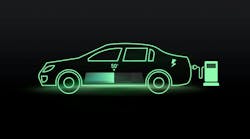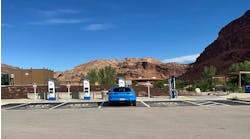To jumpstart EV adoption, many governments and utilities offer incentives to help offset the cost of installing chargers at homes and businesses. But navigating the world of EV charger rebates can feel like a confusing labyrinth. BriteSwitch, a firm specializing in capturing local, utility, state, and federal rebates/incentives for businesses, debunks the five biggest myths about EV charger rebates.
Myth 1: Any Charger Will Qualify for a Rebate
Most people don't realize that not all EV chargers are equal when it comes to rebates. Some programs limit incentives to a specific set of chargers the organization previously approved. Currently, 28% of rebate programs require a charger to be on an approved product list (APL) to get an incentive. This percentage applies to both residential and commercial rebates.
Additionally, some programs have an approved network list (ANL), meaning the charger must be connected to a certain network to qualify for incentives. This requirement is much more common for commercial/public chargers, with 13% of programs having an approved network list. Some programs may also require that the charger is ENERGY STAR certified.
To further complicate matters, in 2024, some programs are rolling out new technical criteria. For example, the standard, ISO 15118, is becoming more important for incentives. This requirement was previously seen mostly in California, but it's spreading across the country. The New York make-ready programs started requiring ISO 15118 this year, and programs in Oregon have also announced that they'll require ISO 15118 in the future. Additionally, federally funded chargers must support OCPP 2.0.1 and ISO 15118-2 by 2025. With that in mind, we expect this requirement to see a broader rollout in the coming years.
Myth 2: All Rebates Come From the Electric Utilities
A common misconception is that electric utilities are the sole providers of EV charger rebates. While utilities are significant players, rebates also come from various other sources that are trying to help build electric charging infrastructure in North America.
Utility Programs: Utilities provide a majority of EV charger rebates, often offering multiple programs to serve different markets. A popular subset includes "make-ready" incentives, which cover the cost of infrastructure needed to support EV charging.
County/Regional Programs: These programs can span multiple towns and utilities, like California's Air Districts, offering additional rebates in addition to local utility programs.
City/Municipal Programs: Targeted at single cities or municipalities, these programs can be the hardest to track due to the sheer number of towns in the US, each potentially having unique incentives.
State Programs: Twenty-four states have statewide programs, which can be competitive grants or operate like traditional rebate programs.
Federal Programs: Federal incentives, like the 30C Tax Credit, provide broad coverage and offer significant tax credits for residential and commercial EV charger installations.
This variety of sources makes it harder to determine which programs might apply to a specific location. If you're only looking at the electric utilities, you're missing a lot of rebate potential.
Additionally, some programs can be combined, or stacked, to provide even higher incentives for a project. Understanding the different sources and how they can work together is crucial for maximizing the benefits.
Myth 3: Programs Are Similar to Energy Efficiency Rebates
Many electricians and distributors looking to branch into the EVSE market see it as a natural progression of their business. If they're already familiar with the rebate programs for energy-efficient products like lighting, they think EV charger rebates will be similar. Unfortunately, that's not the case.
Rebate programs for lighting and HVAC are built around saving energy. EV chargers, on the other hand, use more energy. They're still considered green because they're shifting power away from fossil fuels and ultimately to more clean renewable resources, but in the meantime, they will lead to increased electric demand, meaning being part of an energy conservation rebate program wouldn't make sense.
Less than 10% of EV charger rebate programs fall under the same programs as commercial lighting. Even when the same organization offers both types of rebates, there are often different processes, application portals, and staff to work with. Funding is also independent, meaning lighting may be out of funding, but EV chargers might still have monies available. In addition, the rebate process for EV chargers is also considerably longer than energy efficiency rebate applications.
Myth 4: Federal 30C Tax Credit Eligibility
The 30C Tax Credit, which provides up to 30% of the cost of an EV charger installation, is also a commonly misunderstood incentive. As part of the Inflation Reduction Act (IRA) passed in 2022, new rules required that an EV charger installation must be in an "approved census tract" to qualify for the 30% tax credit. These tracts are typically low-income or rural locations, but determining if a specific project would qualify was tricky.
The confusion stemmed from the fact that these specific qualifying census tracts were relatively unique to this legislation. The IRS did not provide clarification on which specific tracts would qualify until January 2024, over a year after the new rules went into effect. Thankfully, tools are now available to confirm eligibility. According to the White House, 2/3 of Americans can qualify for the 30C tax credit but eligibility will come down to the specific census tract where a charger is installed. Because of the unique way these tracts are determined, it's always best to search by full address rather than going with your instincts; the rules for "low-income" can create some surprising results depending on the area.
Myth 5: NEVI is the Only Rebate for DCFC / Level 3
People often think about the NEVI program when talking about rebates for Level 3/DCFC fast charging. NEVI stands for the National Electric Vehicle Infrastructure (NEVI) Formula Program, and as part of it, the Biden Administration allocated $5 billion to help build charging infrastructure along major highways across the country.
The problem with NEVI programs is they are notoriously hard to get. The Federal NEVI rules have a few universal requirements like the chargers must be made in America and installed along certain transportation corridors, but each state also chooses how to structure its program. It makes it much more difficult to understand the requirements of each state's NEVI offering.
Typically, these NEVI programs are competitive grants, where applicants are evaluated based on various criteria. Consequently, submissions often face fierce competition. For instance, Texas received 280 proposals for Round 1 of their NEVI program, but only 50 were ultimately chosen.
Thankfully, these programs aren't the only incentives available. NEVI-funded rebate programs only account for 20% of incentives for Level 3/DCFC chargers. Many electric utilities and states also offer incentives for Level 3 installations. These alternate rebate programs are usually much less restrictive than the NEVI-funded ones and are structured more like a standard incentive program, not a competitive bid.
Understanding EV Charger Rebates is Key to Success
EV charger rebates are complicated, but understanding them is essential for success in the market. These five myths are just the tip of the iceberg. You should take the time to fully understand the programs you'll be working with. These rebates not only reduce upfront costs but also improve the overall business case for EV charger deployment.



